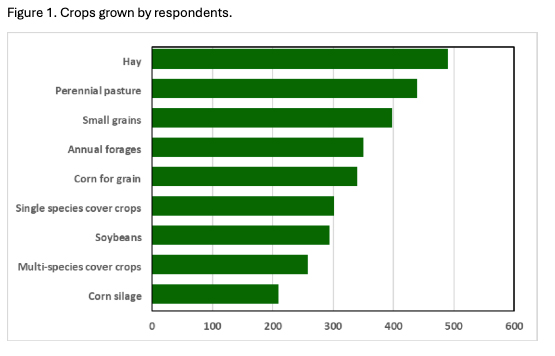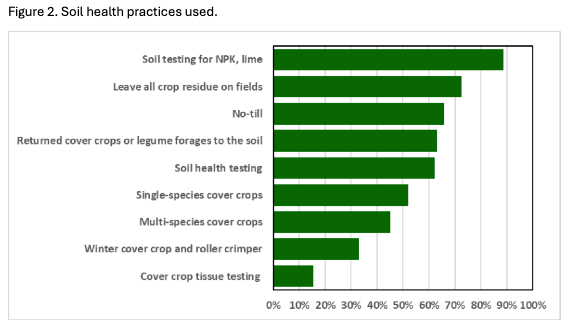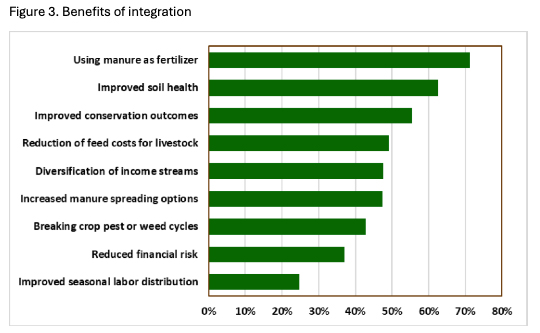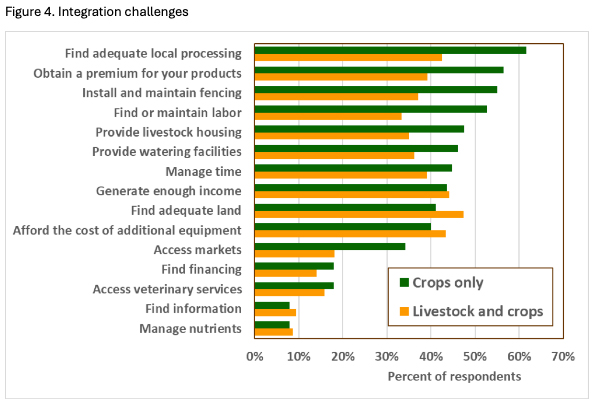Growing Beef Newsletter
July 2024, Volume 15, Issue 1
Farmer views on livestock integration
Denise Schwab
One of the multi-state projects our beef team has been involved in is the Match Made in Heaven: Livestock + Crops project in conjunction with Green Lands Blue Waters. This is a three-year, six-state effort to examine livestock and grain integration to increase ground seeded to forages and improve soil health. One component of that project was a survey of farmers examining their views of integrating livestock into cropping operations. Farmers from Iowa, Illinois, Indiana, Minnesota, Missouri and Wisconsin were invited to complete an on-line survey during 2023 and early 2024. We targeted three groups of farmers: those who only grain farm, those who grain farm and have livestock, and those who only raise livestock.
The preliminary results have just been released from the more than 600 responses across 25 states. On average the producers were 49 years old, had been farming for 24 years, owned 252 acres and rented an additional 244 acres. About 90% of the farmers who responded to the survey raise livestock and only about 10% of the farmers responded who did not raise livestock in the last three years.
Not surprisingly, beef cow-calves were the most common livestock category raised by respondents on 2/3 of the farms, and just under half finished or backgrounded cattle. About 30% of the respondents raised sheep and about 10% milk dairy cows. Logically hay was the crop grown by the most respondents followed by perennial pasture, small grains, and annual forages (see Figure 1), although corn and beans still monopolized the most acres grown. More than 80% of respondents said they used some form of managed rotational grazing, and over half graze crop residues and cover crops.

Respondents were asked about their soil management practices, and Figure 2 shows some of the most common soil health practices used. They were also asked about their motivation for making farming decisions, and over 70% said soil health and minimizing erosion impacted decisions while high yields only accounted for less than 30% of their decisions, and eligibility for farm programs only accounted for less than 40% of their decisions.

We have long touted the benefits of integrating livestock and crop enterprises, but respondents were asked to identify what they perceived as the biggest benefits of integrating livestock. Figure 3 shows they valued manure as fertilizer, soil health and conservation as their top three benefits.

Integrating livestock into cropping operations does not come without challenges, and both crop only and livestock/crop participants were asked to identify the main challenge from their perspective. Figure 4 shows there were differences between those without livestock and those who currently raised livestock.

The preliminary survey results are still being compiled but will be released soon. Other components of the project are case study examples of livestock integration, a resource list and field days. The Iowa field day will be August 22 at 5:30 PM at the Damien and Rick Matt farm, 3738 Birch Road, Clermont. Features of Matt’s field day include crop rotation including annual forages, rotational grazing components including perennial pastures, winter/summer annual forages, corn stalks, stockpile/swath grazing, addition of ewe flock to follow graze cattle, fencing system, water system, and warm season perennial pasture seeding. If you are interested in attending please preregister with Deb Kahler at 563-425-3331 or dkahler@iastate.edu.
More information on the project can be found here. This project is supported by the National Institute of Food and Agriculture, U.S. Department of Agriculture, under agreement number 2021-38640-34714 Am 3 through the North Central Region SARE program under project number LNC21-453.
This monthly newsletter is free and provides timely information on topics that matter most to Iowa beef producers. You’re welcome to use information and articles from the newsletter - simply credit Iowa Beef Center.
